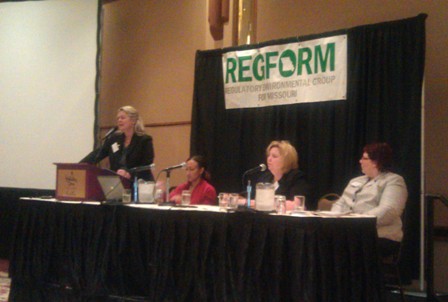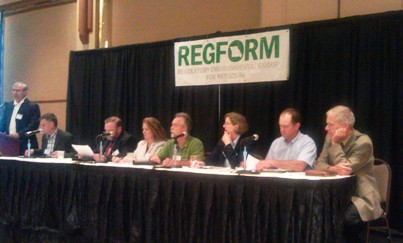|
|
|
|
|
Volume V, Issue 35
| September 19, 2011 |
|
|
Click HERE to Visit Ozarks Water Watch Website to find:
- Current Events
- Newsletter Archives
- Projects Updates
- Water Quality Info
- Maps
- Links
- Pictures & Videos
- News Articles
www.ozarkswaterwatch.org
Want to join a Watershed Group? Click on the site you want to join...
Table Rock Lake Water Quality
http://www.trlwq.org
James River Basin Partnership
http://www.jamesriverbasin.com
Kings River Watershed
http://www.kingsriverwatershed.
org/about_us.html
Illinois River Watershed Ptshp
http://www.irwp.org/
Elk River Watershed
http://www.erwia.org/
Friends of the North Fork and White River
www.friendsoftherivers.org
Save the Illinois River
www.illinoisriver.org
|
|
Upcoming Events:
4-State Watershed Academy
Sept. 29th & 30th
For more information: Click HERE
|
|
|
Water Quality: How Clean and at What Cost?
David Casaletto, Executive Director, Ozarks Water Watch
Earlier this year, the Missouri legislature passed House Bill 89. The bill was originally filed as a couple of pages with the purpose being to extend the ability of the Missouri Department of Natural Resources (MDNR) to assess water permit fees. When finally passed and signed the now 45 page bill did extend the permit fees but it also contained some other interesting provisions. The one I want to talk about today is affordability. Here is a portion of the bill language (click on the link to the bill above and go to page 41 for the complete text):
644.145. 1. When issuing permits under this chapter for discharges from combined or separate sanitary sewer systems or publicly-owned treatment works, or when enforcing provisions of this chapter or the Federal Water Pollution Control Act, 33 U.S.C. 1251 et seq. pertaining to any portion of a combined or separate sanitary sewer system or publicly owned treatment works, the department of natural resources shall make a finding of affordability upon which to base such permits and decisions, to the extent allowable under this chapter and the Federal Water Pollution Control Act.
2. When used in this chapter and in standards, rules and regulations promulgated pursuant to this chapter, the following words and phrases mean:
(1) "Affordability", with respect to payment of a utility bill, a measure of whether an individual customer or household can pay the bill without undue hardship or unreasonable sacrifice in the essential lifestyle or spending patterns of the individual or household, taking into consideration the criteria described in subsection 3 of this section;
(2) "Financial capability", the financial capability of a community to make investments necessary to make water quality-related improvements.
Last week I attended a 2 day water conference in Columbia, MO hosted by RegForm (Regulatory Environmental Group for Missouri). The many speakers included 3 from EPA Region 7, 11 from MDNR, 2 from the University of Missouri, a Missouri Clean Water Commissioner and various environmental lawyers, consultants, engineers, water quality groups, and others in the industry.
 | | MDNR Director Sara Parker Pauley addresses the RegForm Water Conference in Columbia, MO |
If you read over the agenda, the topic of affordability only appears in reference to the last session where House Bill 89 was discussed. But in fact the issue of affordability was a reoccurring theme throughout the conference. A speaker on day one said that we have made great strides in the last almost 40 years since the Clean Water Act was passed. But as we continue to clean our waters to higher and higher levels and for example to protect "streams" that are actually man made or normally dry ditches, the cost to the public dramatically increases. He made the comparison to a rubber band that is getting stretched tighter and tighter and when it snaps, when the public says "Enough, we can no longer afford this high of a level of protection", we will not just revert back to where we are today, but may actually lose much of the water quality advances we have achieved since the 70's. Like a pendulum swinging, as it swings back, it does not stop in the middle but will continue to swing to the other extreme.
I have a friend that has worked in the sewer and wastewater industry for many years and is a licensed operator. I have heard him say many times that with the application of enough money, he can make dirty water as clean as you want it. Just as a TMDL (Total Daily Maximum Load) is the measure of how much of a pollutant you can put into a stream before it is no longer clean enough for its intended uses (swimming, fishing, boating, etc.) the time may have come to ask the question how much money is the public willing to spend on clean water before they say "No more!". As a water quality organization, Ozarks Water Watch is concerned that we do not lose all the hard fought gains we have achieved over the years. An honest and open dialogue on affordability among all stakeholders may help insure the "rubber band does not snap".
During the conference last week, one of the speakers from EPA said that EPA must enforce the Clean Water Act (CWA). But they went on to say that the CWA was written in a different time and when the environment was in a much different condition and we lacked the scientific tools we now have today. They went on to say that it may be time to reexamine the act and make needed changes. And that at this time, affordability, for the most part, does not come into play during EPA's enforcement activities.
 | | Session Entitled "An Adult Conversation on the State of the Water in Missouri" featured representatives from EPA, MDNR, Clean Water Commission, Large Municipal Government, Water Quality Organizations, Environmental Engineering Firm, and Municipal Utility Association. |
The Missouri legislature has told MDNR they must look at affordability on every wastewater permit they write. There are other states that have either passed or are considering similar laws. Everyday in our personal lives we also make decisions based on what we can afford, many that affect our health and well being. One of the sessions at last week's conference was entitled "An Adult Conversation on the State of the Water in Missouri". It seemed that many of the conference attendees agreed that the time has come to have that same adult conversation on affordability - or risk losing the clean water strides we have gained.
 | | Clean, Clear Ozark Stream. |
|
____________________________________
Quote of the Week "Respect your fellow human being, treat them fairly, disagree with them honestly, enjoy their friendship, explore your thoughts about one another candidly, work together for a common goal and help one another achieve it." - Bill Bradley __________________________ Current News Articles |
|
Report: Feds stumble over limiting drugs in water By JUSTIN PRITCHARD The Associated Press September 8, 2011
Federal regulators who are supposed to decide whether to impose limits on prescription drugs in U.S. drinking water still aren't even sure which pharmaceuticals pose human health risks at the low concentrations scientists are finding, government investigators say in a new report.
What began several years ago as a coordinated effort among federal agencies to analyze what -- if anything -- should be done about hormones, antibiotics, painkillers and other drugs in tap water has fizzled, according to a report released Thursday by the Government Accountability Office.
The solution proposed by GAO investigators: Another federal "workgroup" to tackle the issue systematically. The lack of coordination among regulators persists three years after an Associated Press investigation revealed that traces of pharmaceuticals were passing through treatment plants and into drinking water supplies nationwide.
The main source of the contamination is medicine that people take, but that their bodies don't fully absorb. Some of the active ingredients are flushed when people use the toilet, beginning a journey to sewage plants, into waterways that are drinking water sources, and -- after further treatment to make it potable -- back to the kitchen sink.
Representatives of water utilities and pharmaceutical manufacturers say that the low concentrations pose no human health risk -- that a person would need to drink thousands of glasses of water to get a typical therapeutic dose. Research cited in AP's original 2008 investigation suggested cause for concern: Even very small amounts of unwanted drugs could do cumulative harm to people who regularly drink water, in part because they may combine with other pharmaceuticals to unforeseen effect, according to researchers. (more)
To read more, Click HERE.
____________________________
|
Would You Drink Recycled Sewage? Why It Grosses Us Out
Live Science
Rachael Rettner, Staff Writer
For years, we've been able to turn our own sewage into clean, drinking water. Such technology would seem like an ideal solution for water-strapped regions. But the technology remains sparsely used. And even when it is employed, no one actually drinks the water - not directly at least. Why not? Part of the reason is the "ick" factor - we're reluctant to imbibe anything we think has once been in the toilet. "You can get rid of the actual contaminants in the water," said Carol Nemeroff, psychologist and professor of social and behavioral sciences at the University of Southern Maine. "What you can't do is unhook its original identity as sewage." Psychologists are working to understand our misgivings and just what it would take to get people to drink this water. Ick factor Recycled water that is potable goes through a rigorous purification process designed to filter out and kill off anything that would make us sick. Once it's done, the water is completely safe to drink, said Brent Haddad, a professor of environmental studies at the University of California, Santa Cruz. "It is so clean that you have to add back minerals for flavor," Haddad said. "It comes out the equivalent of distilled water." Our repulsion to drinking recycled sewage can be explained by one of the principles underlying human beliefs called "magical contagion." The idea here is that once two objects come into contact, they are always in contact, or continue to influence each other, even if they no longer actually touch. "Contagions" can be both positive and negative. For instance, this way of thinking is why your grandmother's ring is more valuable to you than a replica would be, Nemeroff said. Such a mindset, though not rational, is evolutionary helpful, Nemeroff said. "We are making decisions in daily life all the time with incomplete information," Nemeroff said. "We rarely can sit down and logically think of the pros and cons of everything we do." (more) To read more, Click HERE. _____________________________ |
Deep lake fish kills attributed to oxygen, water temperature Arkansas Game and Fish Commission
09/15/2011 MOUNTAIN HOME - Dead fish in Bull shoals, Norfolk and Beaver lakes in north Arkansas have resulted in questions and concerns from a number of Arkansans. It is a natural and somewhat seasonal phenomenon, according to Ken Shirley, a veteran district fisheries biologist with the Arkansas Game and Fish Commission. The situation was complicated this year because of unusual and prolonged high levels on the lakes resulting from heavy spring rains. Shirley said, "High springtime inflows into the large reservoirs are a great benefit to our fisheries. The resulting huge spawns of crappie, walleye and largemouth bass often dominate those lake fisheries for years. Similar spawns of threadfin or gizzard shad, sunfish, and invertebrates result in fast growth of all our game fish," he explained. "However, this is not without its cost. Access to our waters is often limited or even damaged," he added.
"Another detriment also is quite common though less well known by the angler. Organic matter like leaves flushed into the lakes decays, taking up oxygen in the cold water below the thermocline," Shirley says. The thermocline is the point where shallow warm water meets cold deep water.
"While many cool water fish like walleye and striped bass concentrate at the thermocline where they can acclimate to the temperature and water quality conditions, there is also often a deep plume of cold oxygenated water flowing along the bottom which also has fish."
Shirley explained that fish using that deep plume of oxygenated water have to travel up through a deep or anoxic area to reach more abundant oxygen.
"Many do not make it. If they do, they may find the surface water too hot for them to acclimate quickly or their gas bladder expands so much that they pop to the surface, unable to swim back down, eventually dying from the bends or temperature shock."
Striped bass, walleye and yellow perch are the most numerous of fish being found dead in recent days on two of the lakes. Beaver Lake doesn't have a population of yellow perch and the kill in Beaver Lake primarily affected only a few walleye and striped bass.
(more) To read more, Click: HERE. |
|
|
|
Contact Info
OZARKS WATER WATCH MISSOURI OFFICE ARKANSAS OFFICE
David Casaletto, President PO Box 636, 2 Kissee Ave., Ste. C 1200 W. Walnut, Ste. 3405
(417) 739-5001 Kimberling City, MO 65686 Rogers, AR 72756
contact@ozarkswaterwatch.org
|
|
|
|
|